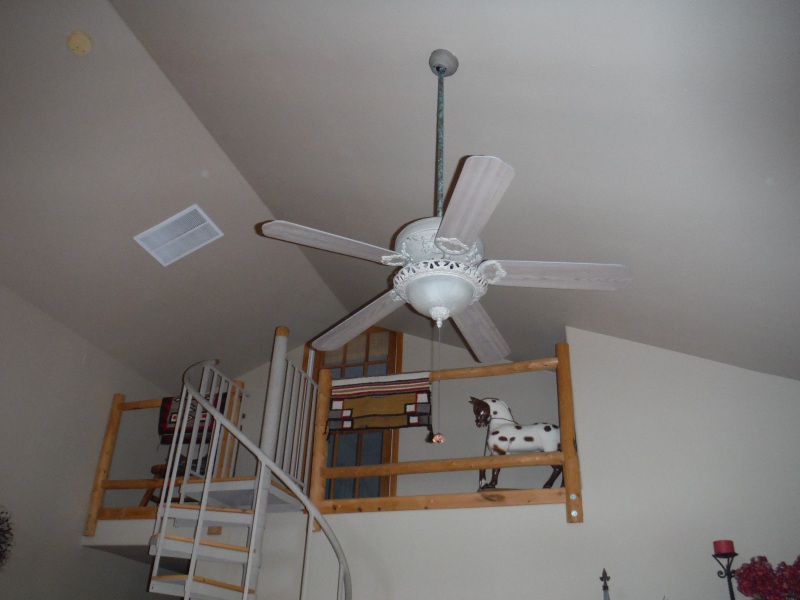At yesterday’s home inspection, WIN Home Inspection Salem, I was reminded once again that most people do not understand how to use a ceiling fan. There is more to a ceiling fan than just being decorative and spinning blades. Most ceiling fans, at the very least 99%, are three speed and they are also reversible. Ceiling fans can blow air down or they can blow air up. It’s easy to understand that if we are sitting under a ceiling fan and it is blowing air down on us we feel cooler. Without going into a bunch of science, as the air blows across our skin, the moisture on our skin, sweat, evaporates. Evaporation is a cooling process. I can still remember, barely, the days when people in arid climates would hang a canvas bag of water on the bumper of their car so they would have cool water to drink when they stopped for a break. The canvas would let water slowly seep to the outside of the bag, the sun would evaporate the water and the water inside the bag would cool. Simple science, but effective. You can think of yourself as a bag of water seeping moisture though the skin. In the summer the air from the blowing fan will cool you. If the fan isn’t cooling you fast enough, mist your skin with water.
In the winter you don’t want to be cooled so you reverse the fan and blow it up against the ceiling. Blowing up causes the lower cool air to be sucked up through the fan and forces the warmer air at the ceiling to move along the ceiling, down the walls and back along the floor to the fan where it is sucked up by the fan, pushed against the ceiling…etc. This slow moving current in the room fills the room with warm air.
You are probably wondering, why not just suck the warm air off the ceiling, sit under the fan and let it warm you up as it blows down? Two reasons, you are a bag of water and the warm air blowing across your body will evaporate any moisture on your skin, cooling you. The second reason is that if you blow the warm air down it will quickly rise again and the area under the fan may be warm but the perimeter and corners of the room will be cool. Blowing the air against the ceiling, down the walls, into the corners and long the floor warms the whole room.
If you could see the warm air, you would see it coming out of your heat registers, wall heater or baseboard heaters, rise to the ceiling and stay there. If you have a well insulated ceiling the heat will eventually build up in the room, first heating your head and slowly moving down your body until the heat reaches the height of wall thermostat, about 5’ off the floor in most cases, telling the thermostat that the room is warm, shutting the heat off, leaving your lower parts cool. This is a very ineffective use of heat and energy. If your ceiling is not well insulated, it takes longer for the heat to build from the ceiling down, because a lot of heat is escaping through the ceiling, and your heater will run much longer. (see my blog, “Insulation Matters.”)
So how do you know which direction the fan is blowing? 99.9% of the time if the reversing switch is switched up, it blows up, switch down, air blows down.
Rarely will your fan have a side to side switch, but if it does, switched to the right it blows up and left it blows down. Another easy way to tell which direction it’s blowing is if the leading edge of the blades are tipped down, it’s blowing up. Conversely, if it’s tipped up, it’s blowing down.
If you’re not convinced, take this challenge. Turn on your heat, let the room warm up until the thermostat shuts the heat off. Quickly take a temperature reading at the ceiling and then one at the floor level. I promise you will be surprised at the temperature difference. The next time the heat kicks on, start blowing your ceiling fan against the ceiling. When the heat kicks off take the temperature at the ceiling and floor again. I did this test in my own home. With the fan off the difference was ten degrees. With the fan on, the difference was one degree. I can honestly tell you that in our home the ceiling fan blows against the ceiling day and night, all winter long.
The cost of running a ceiling fan is about 20-25 cents a day on high speed, depending on the size of the fan. If the fan keeps your home warmer and keeps your furnace or heater from kicking on only one less time a day, you have saved a lot of money.
If you don’t have ceiling fans in your home, consider installing some. If that’s not a possibility or until then, read my blog, “Leave Your Furnace Fan ON!” Using both these suggestions your home will be warmer and cost you less for energy.
Anyway…for what it’s worth.


